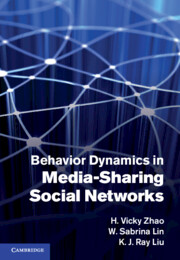Book contents
- Frontmatter
- Contents
- Preface
- Part I Introduction
- Part II Behavior forensics in media-sharing social networks
- Part III Fairness and cooperation stimulation
- 8 Game-theoretic modeling of colluder social networks
- 9 Cooperation stimulation in peer-to-peer video streaming
- 10 Optimal pricing for mobile video streaming
- Part IV Misbehaving user identification
- Part V Media-sharing social network structures
- References
- Index
10 - Optimal pricing for mobile video streaming
from Part III - Fairness and cooperation stimulation
Published online by Cambridge University Press: 28 April 2011
- Frontmatter
- Contents
- Preface
- Part I Introduction
- Part II Behavior forensics in media-sharing social networks
- Part III Fairness and cooperation stimulation
- 8 Game-theoretic modeling of colluder social networks
- 9 Cooperation stimulation in peer-to-peer video streaming
- 10 Optimal pricing for mobile video streaming
- Part IV Misbehaving user identification
- Part V Media-sharing social network structures
- References
- Index
Summary
Mobile phones are among the most popular consumer devices; the recent developments of 3G networks and smart phones enable users to watch video programs by subscribing to data plans from service providers. Because of the ubiquity of mobile phones and phone-to-phone communication technologies, subscribers can redistribute the video content to nonsubscribers. Such a redistribution mechanism is a potential competitor for the service provider and is very difficult to trace, given users' high mobility. The service provider must set a reasonable price for the data plan to prevent such unauthorized redistribution behavior and to protect the provider's own profit. In this chapter, we analyze the optimal price setting for the service provider by investigating the equilibrium between the subscribers and the secondary buyers in the content redistribution network. We model the behavior between the subscribers and the secondary buyers as a noncooperative game and find the optimal price and quantity for both groups of users. Such an analysis can help the service provider preserve the profit under the threat of the redistribution networks and can improve the quality of service for end users.
Introduction
The explosive advance of multimedia processing technologies is creating dramatic shifts in the ways that video content is delivered to and consumed by end users. Also, the increased popularity of wireless networks and mobile devices has drawn a great deal of attention in the past decade about ubiquitous multimedia access in the multimedia community.
Information
- Type
- Chapter
- Information
- Behavior Dynamics in Media-Sharing Social Networks , pp. 195 - 218Publisher: Cambridge University PressPrint publication year: 2011
